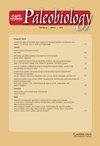上三叠统牙形刺生长异速生长和齿形地形支持营养分化和臼齿样元素功能
IF 2.7
2区 地球科学
Q2 BIODIVERSITY CONSERVATION
引用次数: 4
摘要
牙形石元素具有很高的形态进化率,但这种差异的驱动因素一直存在争议。食品加工表面的尺寸与整个p1元素之间的正异速生长关系被用来证明这些元素进行了机械消化。如果涉及食品加工,元素的表面应以与动物能量需求增加成比例的速度生长。这种功能推断依赖于这样的假设:动物能量需求的增长速度(=质量0.75)比牙齿面积(=质量0.67)快。我们基于动物的代谢率重新评估了这一假设,并使用个体发生序列的3D模型计算了晚三叠世共发生类群Metapolygnathus communisti和Epigondolella rigoi的平台p1元素的异速生长。在这两个物种的平台和元素尺寸上都发现了正异速,这支持了一种抓牙假说,该假说是基于牙形刺的代谢率与体重成比例的假设,类似于鱼类和变温动物的代谢率。我们还计算了p1平台表面的曲率,使用狄利克雷法向能量(DNE)作为饮食的代理。DNE值随体重增加而增加,支持牙形石代谢率比体重增加快0.67的假设。我们最终发现,这两个类群的成虫在食物基础上存在差异,这支持营养多样化是导致牙形石元素显著差异的重要原因。本文章由计算机程序翻译,如有差异,请以英文原文为准。
Growth allometry and dental topography in Upper Triassic conodonts support trophic differentiation and molar-like element function
Abstract Conodont elements have high rates of morphological evolution, but the drivers of this disparity are debated. Positive allometric relationships between dimensions of food-processing surfaces and entire P 1 elements have been used to argue that these elements performed mechanical digestion. If involved in food processing, the surface of the element should grow at a rate proportional to the increase in energy requirements of the animal. This inference of function relies on the assumption that the energy requirements of the animal grew faster (≅ mass 0.75 ) than the tooth area (≅ mass 0.67 ). We reevaluate this assumption based on metabolic rates across animals and calculate the allometry in platform-bearing P 1 elements of Late Triassic co-occurring taxa, Metapolygnathus communisti and Epigondolella rigoi , using 3D models of ontogenetic series. Positive allometry is found in platform and element dimensions in both species, supporting a grasping-tooth hypothesis, based on the assumption that metabolic rate in conodonts scaled with body mass similarly to that in fish and ectotherms. We also calculate the curvature of the P 1 platform surface using the Dirichlet normal energy (DNE) as a proxy for diet. DNE values increase with body mass, supporting the assumption that conodont metabolic rates increased faster than mass 0.67 . We finally find that adults in both taxa differ in their food bases, which supports trophic diversification as an important driver of the remarkable disparity of conodont elements.
求助全文
通过发布文献求助,成功后即可免费获取论文全文。
去求助
来源期刊

Paleobiology
地学-古生物学
CiteScore
5.30
自引率
3.70%
发文量
38
审稿时长
>12 weeks
期刊介绍:
Paleobiology publishes original contributions of any length (but normally 10-50 manuscript pages) dealing with any aspect of biological paleontology. Emphasis is placed on biological or paleobiological processes and patterns, including macroevolution, extinction, diversification, speciation, functional morphology, bio-geography, phylogeny, paleoecology, molecular paleontology, taphonomy, natural selection and patterns of variation, abundance, and distribution in space and time, among others. Taxonomic papers are welcome if they have significant and broad applications. Papers concerning research on recent organisms and systems are appropriate if they are of particular interest to paleontologists. Papers should typically interest readers from more than one specialty. Proposals for symposium volumes should be discussed in advance with the editors.
 求助内容:
求助内容: 应助结果提醒方式:
应助结果提醒方式:


